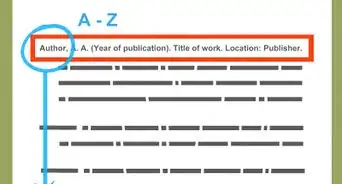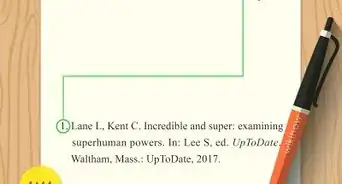This article was co-authored by Emily Listmann, MA. Emily Listmann is a private tutor in San Carlos, California. She has worked as a Social Studies Teacher, Curriculum Coordinator, and an SAT Prep Teacher. She received her MA in Education from the Stanford Graduate School of Education in 2014.
There are 7 references cited in this article, which can be found at the bottom of the page.
This article has been viewed 165,840 times.
When it comes to making a citation, you may find yourself a bit confused. The main point of any citation is to help direct your reader to your source, preferably in proper format, but it's not as hard as it sounds. The three main styles you might be required to use are the Modern Language Association (MLA) style, the American Psychological Association style (APA), and Chicago style. Your teacher should tell you which style you should use.
Steps
Citing the Universal Declaration of Human Rights in APA
-
1Create a sentence for a citation. The first step you take is to create a sentence that quotes or paraphrases the Universal Declaration of Human Rights (UDHR). Otherwise, you have no need to cite the document.
- For example, you could write, "As the Universal Declaration of Human Rights states, 'All human beings are born free and equal in dignity and rights.'"
-
2Make an in-text citation to point the reader to the source. The in-text citation goes at the end of the sentence. Start with the organization. In most cases with a citation, you start with the author. In this case, you don't have a single author but, rather, an organization (an assembly) that collectively wrote and approved the document, the UN General Assembly.[1] Therefore, that's what you begin the citation with.[2] After that, you'll add a comma and the date.
- In the above example, you'd write: As the Universal Declaration of Human Rights states, "All human beings are born free and equal in dignity and rights" (UN General Assembly, 1948).
- The citation goes in parentheses, after the quotation mark and before the period.
- You can also include the citation at the beginning of the sentence, such as in the following sentence: As the UN General Assembly (1948) determined over 60 years ago, all people have certain inalienable rights at birth.
Advertisement -
3Make an end reference that contains the complete source. The end reference provides more information for the reader, helping them to find the document. Since this document is fairly common, it's not as essential to include all the information you would in a normal citation. Still, it's best to include as much information as you can.[3]
- The citation should look like the following: UN General Assembly. (1948). Universal declaration of human rights (217 [III] A). Paris.
- The designation 217 (III) A refers to the document number. Also, the General Assembly was convened in Paris, so you add that as the location.
-
4Add the website if you prefer. Since the UDHR is fairly commonplace, you don't strictly need a web address. However, adding it certainly doesn't hurt, as it points your reader in the right direction.[4]
- As an example, the completed citation would look this way: UN General Assembly. (1948). "Universal declaration of human rights" (217 [III] A). Paris. Retrieved from http://www.un.org/en/universal-declaration-human-rights/
Citing the UDHR in MLA
-
1Start with a sentence that needs citation. Once again, you need to have a sentence that either paraphrases or directly quotes the UDHR in it. That is the only way you'll need an in-text citation for your sentence.
- Use the same example form above: "As the Universal Declaration of Human Rights states, 'All human beings are born free and equal in dignity and rights.'"
-
2Add an in-text citation to show where you got the information. Like APA style, you need an in-text citation in parentheses. Unlike APA, the citation usually goes at the end of the sentence (the exception being if you cite two different sources in the same sentence). You'll need the author's name (again, the organization, the UN General Assembly). However, instead of the date, you'll use the article number that you're quoting from.[5]
- For example, in this sentence, the citation would look this way: As the Universal Declaration of Human Rights states, "All human beings are born free and equal in dignity and rights" (UN General Assembly art. 1).
-
3Build an end reference that contains the full source information. The MLA has recently updated their style guidelines, making them looser. In other words, the main point is to get the information in there, based on the nine basic elements of author, title of source (such as the book name), the title of container (such as a larger work or website the smaller work is contained in), additional contributors, version, number, publisher, publication date, and location. Obviously, not every source will have all of this information, so you just include as much as you can find.[6]
- Therefore, the end reference will look like the following example: UN General Assembly. "Universal Declaration of Human Rights." United Nations, 217 (III) A, 1948, Paris, art. 1, http://www.un.org/en/universal-declaration-human-rights/. Accessed 6 Sept. 2016.
Citing the UDHR in Chicago
-
1Begin with a sentence that needs a citation. You must always start with a sentence that requires a citation. Generally, that means you need a sentence that either quotes or paraphrases the UDHR. Also, the information should contribute something to your essay.
- You can use the same example: "As the Universal Declaration of Human Rights states, 'All human beings are born free and equal in dignity and rights.'"
-
2Use a footnote. Like APA and MLA, you need to add information to your sentence to tell your reader where you found it. However, unlike APA and MLA, Chicago style requires you to use a footnote. A footnote places a small number at the end of your sentence (after the period), and then a corresponding number at the bottom of the page, where you add your information.[7]
- Go to the end of your sentence, and add a footnote. To add a footnote, first place the cursor at the end of the sentence after the period or quotation mark (whichever comes last). Go to "References" in your word processing software, and choose "insert a footnote." It should place a number at the end of the sentence and down at the bottom of the page.
- It should look like this example: As the Universal Declaration of Human Rights states, "All human beings are born free and equal in dignity and rights."1
-
3Put the information in the footnote. Go to the corresponding footnote at the bottom of the page. Add your footnote citation. Unlike APA and MLA, you generally include all of the information for the citation in the footnote.
- Start with the organization, followed by a comma, and the title. Then add an open parenthesis, a phrase that identifies the type of source, the place of publication, and the year, followed by a close parenthesis. At the end, include the location you found the information (such as the page or article number).
- For instance, your footnote would look like this example: 1. UN General Assembly, "Universal Declaration of Human Rights," 217 (III) A (Paris, 1948), http://www.un.org/en/universal-declaration-human-rights/ (accessed September 6, 2016).
- In the citation, "217 (III) A" is the document reference, while "Paris" is the location and "1948" is the date. The website is where you found the document.
-
4Create an end reference. Your end reference in Chicago style will be very similar to your footnote. Basically, you'll just change some of the punctuation and capitalization to make it an end reference, and put it at the end of your paper.
- The end citation would look this way: UN General Assembly. "Universal Declaration of Human Rights." 217 (III) A. Paris, 1948. http://www.un.org/en/universal-declaration-human-rights/ (accessed September 6, 2016).
- Just change most of the commas to periods, and capitalize what comes after the period.
References
- ↑ https://www.refworld.org/docid/3ae6b3712c.html
- ↑ https://owl.english.purdue.edu/owl/resource/560/09/
- ↑ https://owl.english.purdue.edu/owl/resource/560/09/
- ↑ https://owl.english.purdue.edu/owl/resource/560/10/
- ↑ https://libguides.reading.ac.uk/citing-references/citationexamples
- ↑ https://subjectguides.esc.edu/researchskillstutorial/citationparts
- ↑ https://www.trentu.ca/academicskills/documentation-guide/chicago-style/footnotes-and-endnotes
About This Article
When citing the Universal Declaration of Human Rights in MLA format, add an in-text citation in parentheses that includes the author’s name and the article number that you’re quoting from. For example, after your cited work, you’d write, in parentheses, “UN General Assembly art. 1.” Then, write an end reference that contains information such as the name of the author, the title of the work, the title of the container, additional contributors, version, number, publisher, publication date, and location. To learn how to cite the Universal Declaration of Human Rights in APA format, keep reading!


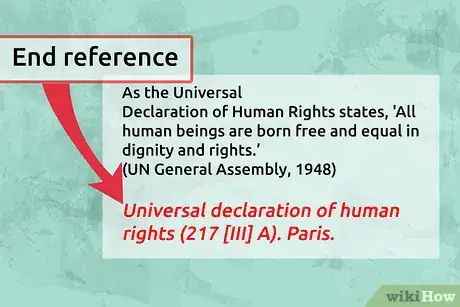

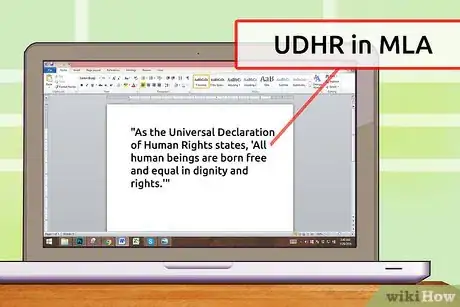

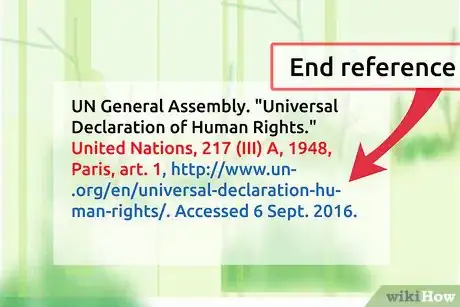


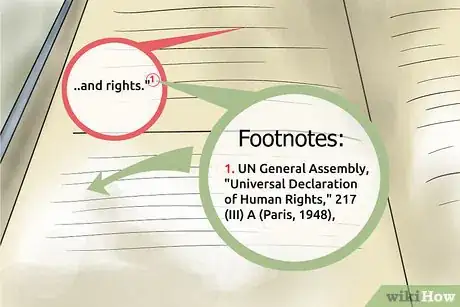
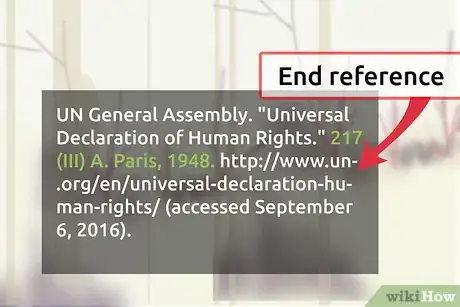



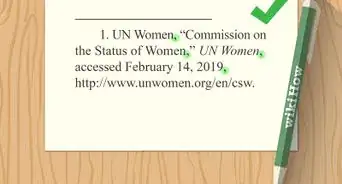



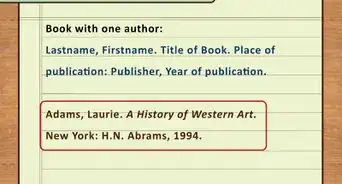


-Step-18.webp)

